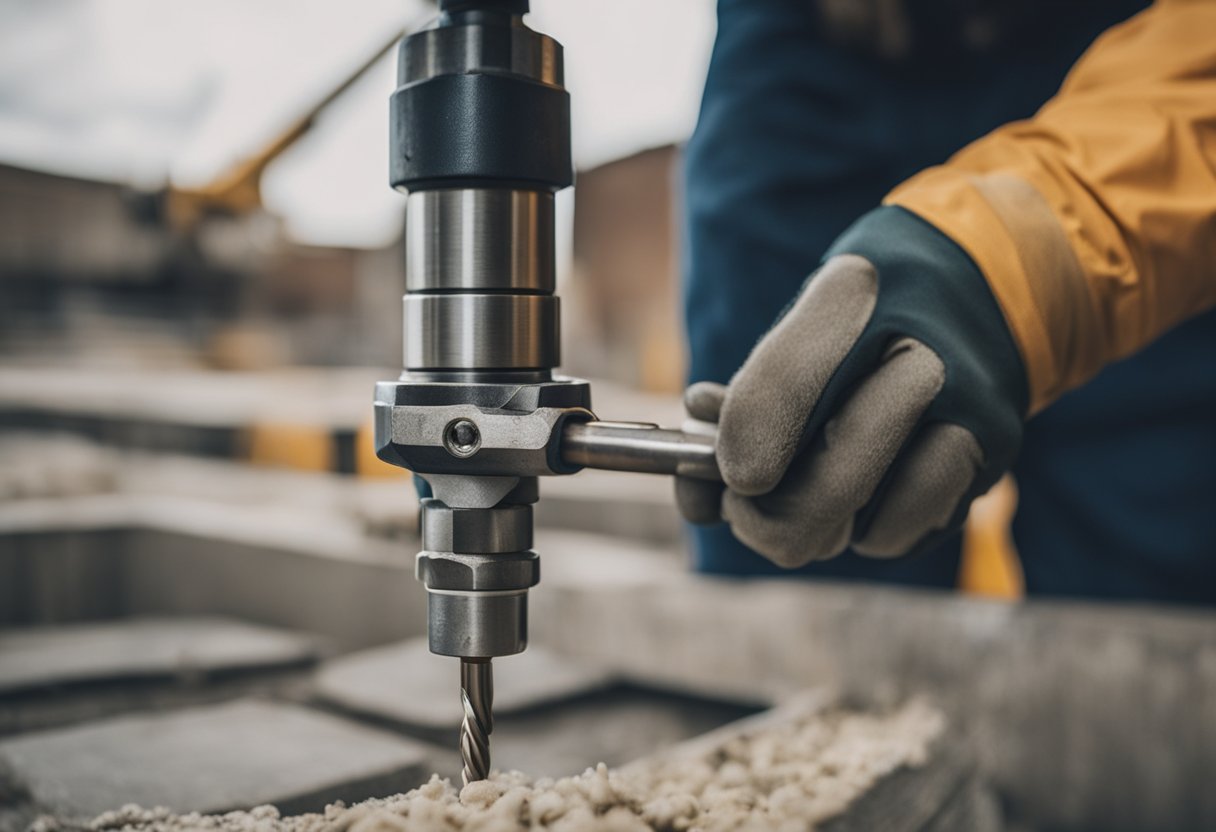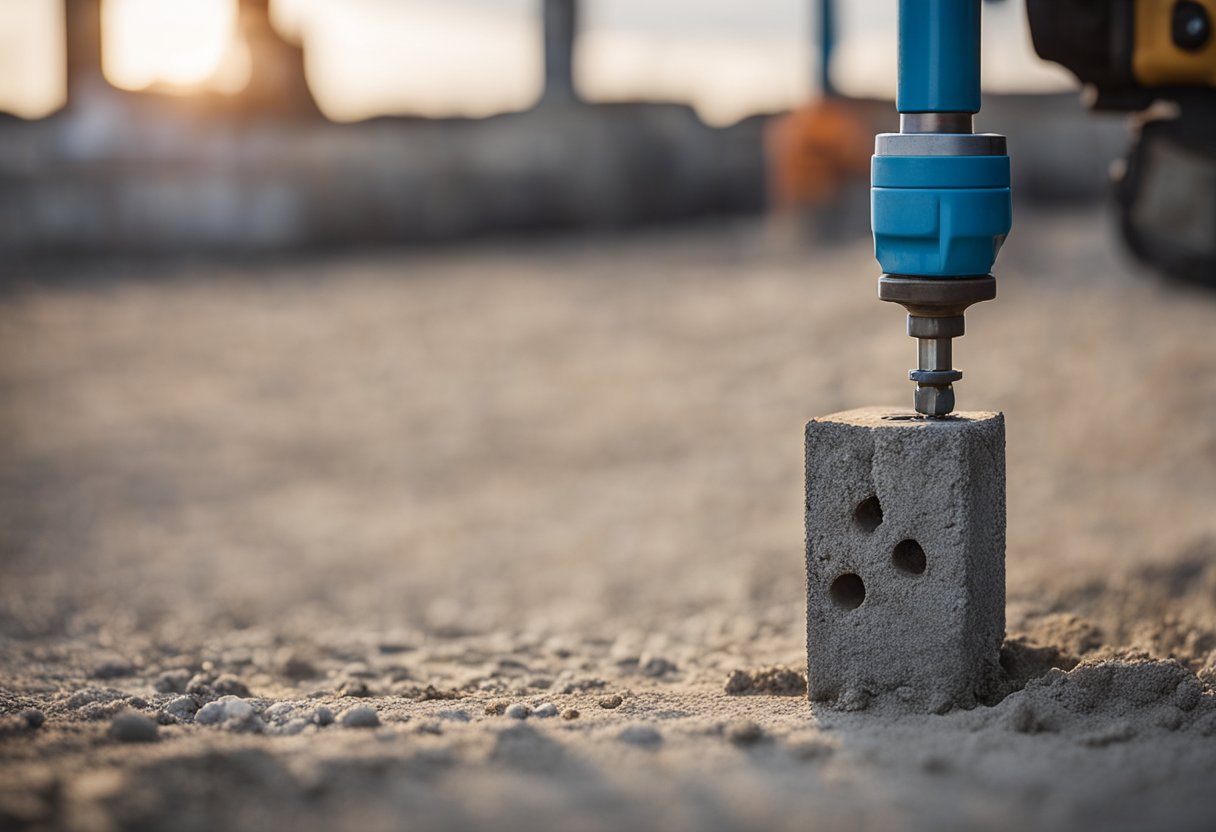When it comes to installing a 3/8 concrete anchor, choosing the right size of drill bit is crucial. Using the wrong size can lead to a loose and unstable anchor, which can be dangerous and costly. In this article, I will guide you on how to choose the right drill bit size for your 3/8 concrete anchor and provide some useful tips on the drilling process and techniques.
Understanding concrete anchors is the first step to selecting the right drill bit size. Concrete anchors are used to secure objects to concrete surfaces. They come in different sizes and types, and each requires a specific size of drill bit for installation. Using the right drill bit size ensures that the anchor is securely embedded in the concrete, providing maximum holding strength.
Types of drill bits for concrete include masonry bits, carbide-tipped bits, and diamond bits. Each type has unique features and is suitable for different drilling applications. Choosing the right type of drill bit for your 3/8 concrete anchor depends on various factors, such as the type of concrete, the anchor diameter, and the drilling technique.
Understanding Concrete Anchors
https://www.youtube.com/watch?v=2u_TdFVSN24&embed=true
As a professional contractor, I understand the importance of selecting the right size drill bit when installing concrete anchors. Concrete anchors are essential for securing objects to concrete surfaces, and there are various types of concrete anchors available, including wedge anchors, sleeve anchors, drop-in anchors, and expansion anchors.
When installing concrete anchors, it is essential to choose the right size drill bit to ensure a secure installation. For a 3/8 concrete anchor, it is recommended to use a 5/16-inch drill bit Drillay. Using the wrong size drill bit can result in the anchor fitting incorrectly or loosening over time, compromising the structural integrity of the installation.
Wedge anchors are a popular type of concrete anchor used for heavy-duty applications. They are designed to expand once they are inserted into a drilled hole, providing a secure connection between the anchor and concrete. To install a wedge anchor, you will need to drill a hole in the concrete that is slightly deeper than the length of the anchor. The size of the drill bit required will depend on the size of the anchor being used.
Sleeve anchors are another type of concrete anchor that is commonly used. They consist of a sleeve that is inserted into a drilled hole, and a bolt that is threaded through the sleeve. As the bolt is tightened, the sleeve expands, securing the anchor to the concrete surface. To install a sleeve anchor, you will need to drill a hole in the concrete that is slightly larger than the diameter of the sleeve.
Drop-in anchors are designed to be used in solid concrete and are ideal for applications where a flush-mounted anchor is required. To install a drop-in anchor, you will need to drill a hole in the concrete that is slightly deeper than the length of the anchor. The anchor is then inserted into the hole, and a setting tool is used to expand the anchor, securing it to the concrete surface.
In conclusion, selecting the right size drill bit is crucial when installing concrete anchors. It is essential to choose the correct size to ensure a secure installation that will last for years to come. As a contractor, I always make sure to use the right size drill bit for the job, and I highly recommend that you do the same.
Types of Drill Bits for Concrete
https://www.youtube.com/watch?v=JuamV760JZI&embed=true
When it comes to drilling into concrete, it’s important to use the right type of drill bit to ensure a clean and precise hole. There are several types of drill bits that can be used for concrete, but the most common are masonry bits, carbide-tipped bits, and steel bits.
Masonry Bits
Masonry bits are designed for drilling into brick, concrete, and other masonry materials. These bits are made from high-speed steel and have a tungsten carbide tip for added durability. Masonry bits are available in a range of sizes, from 1/8 inch to 1 inch or larger.
Carbide-Tipped Bits
Carbide-tipped drill bits are ideal for drilling into hard materials like concrete and masonry. These bits are made from high-speed steel with a tungsten carbide tip for added strength and durability. Carbide-tipped bits are available in a range of sizes, from 1/8 inch to 1 inch or larger.
Steel Bits
Steel bits are the most common type of drill bit and are suitable for drilling into soft materials like wood and plastic. However, they are not recommended for drilling into concrete or masonry as they can quickly become dull and wear out.
In conclusion, when drilling into concrete, it’s important to use the right type of drill bit to ensure a clean and precise hole. Masonry bits, carbide-tipped bits, and steel bits are the most common types of drill bits used for concrete, but it’s important to choose the right one based on the specific job at hand.
Choosing the Right Drill Bit Size
https://www.youtube.com/watch?v=ME3g1OH8Wn0&embed=true
As a professional handyman, I know that selecting the correct drill bit size is crucial when it comes to installing a 3/8 concrete anchor. Using the right size drill bit ensures that the anchor fits correctly and does not loosen over time, which can compromise the structural integrity of the installation.
To determine the correct drill bit size for a 3/8 concrete anchor, you should consider the anchor’s diameter. According to my research, most manufacturers recommend using a 3/8″ masonry drill bit for 3/8″ concrete anchors. This bit size ensures that the hole is the correct size for the anchor to fit snugly and securely.
However, it’s important to note that not all 3/8″ concrete anchors are created equal. Some may require a slightly larger or smaller drill bit size, depending on the manufacturer’s specifications. Therefore, it’s always a good idea to check the manufacturer’s instructions before drilling the hole.
Another factor to consider when choosing the right drill bit size is the type of anchor you’re using. For example, drop-in anchors require a slightly smaller drill bit size than wedge anchors. According to my research, a 5/16″ masonry drill bit is recommended for 3/8″ drop-in anchors, while a 7/16″ masonry drill bit is recommended for 3/8″ wedge anchors.
In conclusion, choosing the right drill bit size is essential when it comes to installing a 3/8 concrete anchor. By considering the anchor’s diameter and the manufacturer’s instructions, you can ensure that the anchor fits securely and does not compromise the structural integrity of the installation.
Drilling Process and Techniques
https://www.youtube.com/watch?v=Lo7veFXq29A&embed=true
When drilling a hole for a 3/8 concrete anchor, it is important to use the correct size drill bit to ensure a secure and effective installation. The size of the drill bit should be 5/16 inch, according to Drillay. Using the right size bit can prevent the anchor from fitting correctly or loosening over time, compromising the structural integrity of the installation.
To determine the correct hole size, measure the diameter of the anchor and choose a drill bit that is slightly smaller. This will allow the anchor to fit snugly in the hole and prevent it from moving or shifting. It is also important to drill the hole to the correct depth, which can be achieved using a depth gauge or measuring tape.
When drilling into concrete, it is important to use a carbide-tipped drill bit, which is designed to withstand the hardness of the material. The drilling process should be done at a slow and steady speed, allowing the drill bit to cut through the concrete without overheating or becoming damaged.
It is also important to use a vacuum or blower to remove any dust or debris from the hole after drilling. This will ensure that the anchor is able to fit securely in the hole and prevent any potential damage or failure.
Overall, drilling a hole for a 3/8 concrete anchor requires careful attention to detail and the use of the correct tools and techniques. By following these guidelines, you can ensure a secure and effective installation that will stand the test of time.
Considerations for Anchor Diameter and Embedment
When it comes to drilling a hole for a 3/8 concrete anchor, there are a few important considerations to keep in mind. One of the most critical factors is the diameter of the anchor itself. The diameter of the anchor will determine the size of the hole that needs to be drilled, which in turn will impact the overall strength and stability of the anchor.
In general, the diameter of the hole should be equal to or slightly larger than the diameter of the anchor. This will ensure a snug fit and prevent the anchor from slipping or shifting over time. In the case of a 3/8 concrete anchor, a 3/8 masonry drill bit should be used to create the necessary hole.
Another important consideration when drilling a hole for a concrete anchor is the minimum embedment depth. This refers to the minimum distance that the anchor must be inserted into the concrete in order to achieve the necessary strength and stability. The minimum embedment depth will vary depending on the diameter of the anchor, as well as the specific type of anchor being used.
For a 3/8 concrete anchor, the minimum embedment depth is typically around 1-1/2 inches. This means that the hole should be drilled to a depth of at least 1-1/2 inches in order to accommodate the anchor. It is important to note that the minimum embedment depth is just that – a minimum. In some cases, it may be necessary to drill a deeper hole in order to achieve the necessary strength and stability.
In addition to the diameter of the anchor and the minimum embedment depth, it is also important to consider the overall length of the anchor. The length of the anchor will determine how much of it is embedded in the concrete, and will therefore impact its overall strength and stability. In general, it is recommended to use an anchor that is at least 1-1/2 times the thickness of the material being fastened. This will ensure that the anchor is strong enough to support the weight and load of the material.
By carefully considering the diameter of the anchor, the minimum embedment depth, and the overall length of the anchor, it is possible to create a secure and stable connection between the material and the concrete. Whether you are working on a DIY project or a professional construction job, taking the time to properly drill the hole for your concrete anchor is an essential step in ensuring a successful and long-lasting installation.
Safety Measures and Best Practices
When working with a 3/8 concrete anchor, it is essential to take the necessary safety measures and follow the best practices to avoid any accidents or damage to the project. Here are some tips to help you stay safe and get the job done correctly:
Wear Safety Equipment
Safety equipment is a must-have when working with power tools and concrete. Always wear eye protection, gloves, and a dust mask to prevent dust and debris from entering your eyes and lungs. Additionally, wear ear protection if you are working in a noisy environment.
Follow ANSI Standards
The American National Standards Institute (ANSI) has set safety standards for power tools and construction equipment. Follow these standards when working with a 3/8 concrete anchor. Use the recommended drill bit size, and do not exceed the maximum torque capacity of the anchor.
Choose the Right Drill Bit
Choosing the right drill bit is crucial when working with a 3/8 concrete anchor. Use a bit that matches the size of the anchor and the material you are drilling into. A bit that is too small may not create a hole that is deep enough, while a bit that is too large may cause the anchor to become loose over time.
Consider Hiring a Contractor
If you are not comfortable working with power tools or do not have experience with DIY projects, consider hiring a contractor to install the 3/8 concrete anchor. A professional can ensure that the anchor is installed correctly and safely.
By following these safety measures and best practices, you can ensure that your project is successful and that you stay safe while working with 3/8 concrete anchors.
Additional Information
When it comes to installing a 3/8 concrete anchor, choosing the right drill bit is crucial. In this section, I will provide you with some additional information that can help you make the right choice.
Firstly, it is important to note that the size of the drill bit you choose will depend on the type of fixture you are installing. For instance, if you are installing a tapcon screw, you will need a masonry bit that is slightly smaller than the diameter of the screw.
Secondly, the material of the anchor is also important. Zinc anchors are suitable for solid concrete, while stainless steel anchors are ideal for load-bearing applications. Plastic anchors, on the other hand, are best suited for lightweight applications.
Thirdly, the rotation mode of your drill is important. Using a hammer drill in rotation mode can help to create friction, which can help to prevent the drill bit from slipping.
Fourthly, it is important to use masonry bits when drilling into concrete. These bits are designed to withstand the hardness of concrete and can help to prevent the drill bit from overheating.
Finally, it is important to wear protective gear when drilling into concrete. Concrete dust can be harmful to your health, so wearing a mask and goggles can help to protect you from the dust.
In summary, choosing the right drill bit for your 3/8 concrete anchor installation requires careful consideration of the type of fixture, material of the anchor, rotation mode of your drill, type of drill bit, and safety gear. By following these guidelines, you can ensure a safe and successful installation.
Frequently Asked Questions
What size concrete bit do I need for a 3/8 anchor?
When installing a 3/8 concrete anchor, it is essential to use the correct size drill bit. The size of the drill bit you need depends on the type of anchor and the size of the hole you need to create. For a 3/8 anchor, you will need a 5/16-inch drill bit. This size is suitable for most 3/8 anchors, including drop-in anchors, sleeve anchors, and wedge anchors.
What size hole do you drill for a 3/8 sleeve anchor?
A 3/8 sleeve anchor requires a hole that is slightly larger than the anchor’s diameter. To drill the hole, you will need a 1/2-inch masonry bit. The hole should be drilled to a depth that is equal to the length of the anchor plus the thickness of the material being fastened. For example, if you are fastening a 3/4-inch thick board to concrete, the hole should be drilled to a depth of 2 1/4 inches.
What size drill bit for a 3/8 hollow wall anchor?
When installing a 3/8 hollow wall anchor, you will need a drill bit that is slightly smaller than the anchor’s diameter. For a 3/8 anchor, you will need a 5/16-inch drill bit. The hole should be drilled to a depth that is equal to the length of the anchor plus the thickness of the material being fastened.
What size is a 3/8 anchor bolt?
A 3/8 anchor bolt has a diameter of 3/8 inch. Anchor bolts are typically used to fasten heavy objects to concrete or masonry. They are available in a variety of lengths and are designed to provide a secure, long-lasting hold.
What is the weight limit for a 3/8 wedge anchor?
The weight limit for a 3/8 wedge anchor depends on several factors, including the type of concrete, the depth of the hole, and the length of the anchor. In general, a 3/8 wedge anchor can support up to 2000 pounds in concrete that is at least 8 inches thick.
What is the diameter of a 3/8 drop in anchor?
A 3/8 drop-in anchor has a diameter of 3/8 inch. Drop-in anchors are designed to provide a secure hold in concrete and other hard materials. They are commonly used to fasten electrical boxes, conduit, and other fixtures to concrete walls or floors.

Hi, I’m Sal Muller of Tooltrip.com. My DIY experience led me to understand essential power tools for home projects. Tooltrip.com guides enthusiasts and professionals in choosing right tools for any job. I provide concise top tool reviews for easier, efficient DIY.






